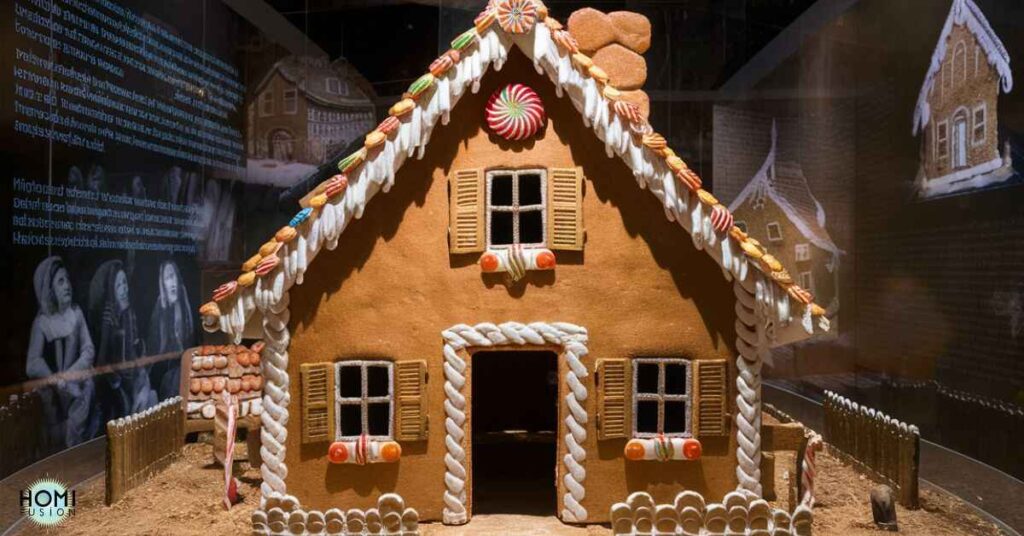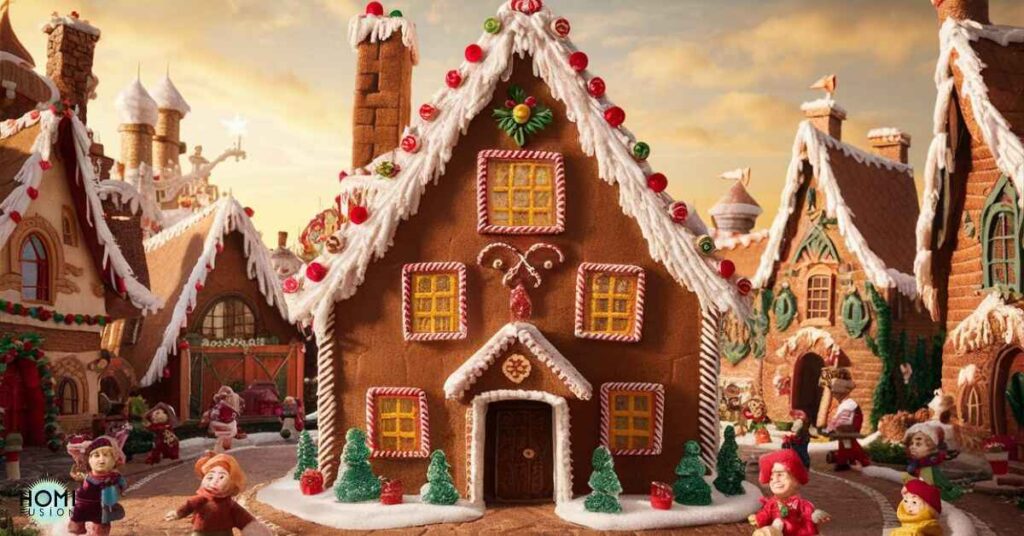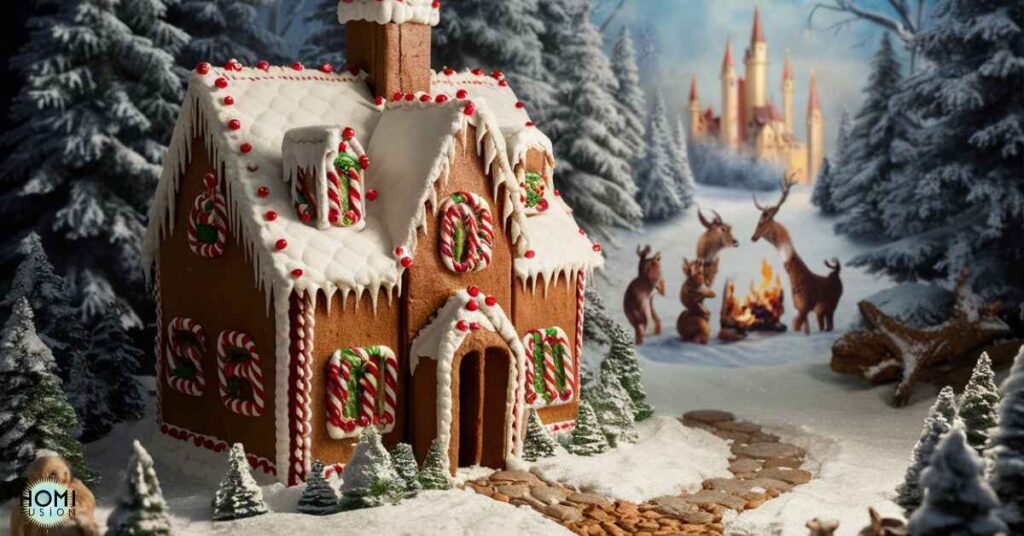The question of which fairytale inspired the first gingerbread house is intriguing. Gingerbread has a long history, going back thousands of years. The fairytale “Hansel and Gretel” is often linked to gingerbread houses, where the siblings find a house made of sweets in the forest.
This story has become a part of popular culture and may have influenced the tradition of creating edible houses. However, there are debates and alternative theories about the true origins of gingerbread houses.
Origins of Gingerbread Houses
Gingerbread houses have a rich and fascinating history that traces back centuries. Exploring their origins sheds light on how this beloved tradition came to be.
Early History of Gingerbread
Gingerbread’s roots can be traced back thousands of years, with ginger cultivation dating back to ancient China. The first known gingerbread recipe may have originated in Greece around 2400 BC.
Its popularity spread across Europe, with references to gingerbread guilds and bakers’ rights protection in Germany.
Evolution into Decorative Forms
Gingerbread evolved from simple bread to intricately shaped and decorated treats. Courtly figures and important guests were honored with shaped gingerbread in Queen Elizabeth I’s era. Shaped gingerbread became popular as gifts and decorations during holidays and celebrations.
Association with Holidays and Celebrations
Gingerbread’s association with festive seasons, especially Christmas, grew over time. The tradition of making decorated gingerbread houses became widespread in Germany in the early 1800s. Stories like “Hansel and Gretel” contributed to the imaginative and decorative aspects of gingerbread houses.
Hansel and Gretel: The Inspirational Fairytale
The tale of “Hansel and Gretel” is often cited as a source of inspiration for gingerbread houses due to its edible house motif.

Overview of the Hansel and Gretel Fairy Tale
“Hansel and Gretel” tells the story of siblings who stumble upon a house made of sweets in the forest.
Description of the Gingerbread House in the Story
The gingerbread house in the tale is adorned with sugary decorations, enticing the hungry children.
Impact of the Story on Popular Culture and Traditions
The impact of “Hansel and Gretel” on popular culture and traditions is profound and enduring. This classic fairy tale has left an indelible mark on various aspects of our society. It has influenced everything from literature and entertainment to culinary traditions. Additionally, it has even impacted psychological analyses.
Literary and Entertainment Influence
Hansel and Gretel” has inspired countless adaptations in literature, theater, film, and television. These adaptations captivate audiences of all ages with themes like bravery and familial love. The tale’s iconic imagery, including the gingerbread house and wicked witch, has become ingrained in popular imagination and storytelling.
Culinary Traditions
The story’s association with a house made of sweets, particularly the gingerbread house, has contributed to the popularity of gingerbread as a festive treat. Especially during Christmas and other holidays, gingerbread houses have become a beloved tradition. Families and communities come together to create and decorate these edible works of art.
Psychological and Cultural Analyses
Psychologists and scholars have delved into the psychological aspects of “Hansel and Gretel.” They explore themes such as abandonment, fear, resilience, and the triumph of good over evil. The tale’s enduring appeal and universal themes have made it a subject of cultural analysis. This highlights its significance in storytelling across different cultures and time periods.
Read this blog: Freestanding Tub Inside Walk-In Shower
Historical Context and Theories
The historical context surrounding gingerbread houses offers intriguing insights into their origins. It also sheds light on their evolution as a cultural phenomenon.

Controversies and Debates
Scholars and historians have debated the exact origins of gingerbread houses. Some trace them back to ancient civilizations like Egypt and Greece. Others attribute their popularity to medieval Europe.
The role of gingerbread in religious and social contexts adds complexity. It includes its use in festivals, weddings, and as love tokens. This aspect enriches its historical narrative.
Influence of “Hansel and Gretel”
One prevalent theory suggests that the publication of the Grimm Brothers’ fairy tale “Hansel and Gretel” in 1812 popularized the concept of gingerbread houses. Particularly, it highlighted the idea of an edible house made of sweets. The story’s themes of survival, temptation, and triumph over adversity resonated with audiences. These themes contributed to the enduring appeal of gingerbread houses.
Alternate Theories and Inspirations
Some alternative theories propose that gingerbread houses were inspired by real-life architectural marvels. Others suggest they are symbolic representations of wealth and prosperity.
The association of gingerbread with holidays, especially Christmas, played a significant role. It shaped the tradition of making decorated gingerbread houses.
The Biggest House
The creation of the largest gingerbread house stands as a testament. It showcases the scale and creativity achievable with this holiday tradition.

Description of the Record-breaking House
The largest gingerbread house, created by Traditions Club in Texas, was massive. It measured an astounding 18.28 meters long, 12.8 meters wide, and 18.28 meters tall. To construct a similar house,
it would require a staggering amount of ingredients, including 820kg of butter, 1,327kg of brown sugar, 7,200 eggs, 3,266kg of flour, and 31kg of ground ginger. The sheer size and complexity of this gingerbread creation resulted in a structure with a whopping 35.8 million calories.
Significance and Impact
The construction of a massive gingerbread house showcases dedication and passion. It reflects individuals and communities celebrating the holiday spirit. These record-breaking feats capture imagination and inspire culinary art.
They also encourage pushing boundaries in festive decorations. The attention garnered by the largest gingerbread house contributes to continued popularity. It fosters appreciation of gingerbread as a cherished holiday tradition.
Continuing the Tradition
The record for the largest gingerbread house may change over time. This occurs as new creations emerge. However, the spirit of innovation and creativity in gingerbread construction remains timeless. Communities and organizations worldwide continue to celebrate the holiday season. They do this by building impressive gingerbread structures. This fosters a sense of joy and camaraderie during this festive time.
The Biggest Village
Exploring the world of gingerbread villages reveals the creativity and community spirit that flourishes during the holiday season.

Overview of Large-Scale Gingerbread Villages
Gingerbread villages are intricate displays with numerous buildings and figurines. They’re made entirely of gingerbread and edible decorations. These villages often capture the essence of a winter wonderland. They include houses, churches, streets, and moving elements like trains and cars.
Notable Examples
Jon Lovitch, sous-chef at the New York Marriott Marquis Hotel, broke the record multiple times. He did this for creating the “largest gingerbread village.” His displays, such as the one at the New York Hall of Science, feature thousands of individual buildings.
These include houses, shops, and even a working train. Another notable example is Bergen’s Gingerbread Town in Norway. There, more than 2,000 individual buildings, ships, cars, and a train are crafted from gingerbread.
Significance and Impact
These large-scale gingerbread villages showcase artistry and craftsmanship. They’re involved in creating edible landscapes that evoke the magic of the holiday season. The attention to detail and creativity in designing these villages inspire awe.
They delight visitors, fostering a sense of joy and wonder during the festive period. The record-breaking feats achieved with gingerbread villages highlight the enduring appeal. They also showcase the cultural significance of this beloved holiday tradition.
Also read: Parker Schnabel’s House: The Alaska Mansion
Frequently asked questions
What story inspired gingerbread houses?
The story that inspired gingerbread houses is “Hansel and Gretel,” with its iconic edible house made of sweets in the forest.
Where did the first gingerbread house come from?
The origins of the first gingerbread house are believed to be from Germany. This happened in the early 1800s. It was inspired by the fairy tale “Hansel and Gretel” and the tradition of decorating gingerbread.
Who is the fairy tale character in the gingerbread house?
The fairy tale character associated with the gingerbread house is the witch from “Hansel and Gretel.”
Where did the gingerbread story come from?
The gingerbread story has ancient roots. Ginger cultivation originated in China around 5,000 years ago. The first known recipe for gingerbread dates back to ancient Greece. This was around 2400 BC.
However, the modern association of gingerbread with festive traditions, including gingerbread houses, can be traced back to Europe. Particularly, it can be traced back to Germany in the early 1800s.
What does the gingerbread house symbolize?
The gingerbread house symbolizes temptation and danger in the story “Hansel and Gretel,” highlighting themes of survival, innocence, and resilience against adversity.
Conclusion
The history of gingerbread houses is a fascinating journey. It intertwines with cultural traditions and storytelling. From its ancient origins to its modern association with festive celebrations, gingerbread houses have become symbolic. They are symbolic of creativity, joy, and community spirit during the holiday season.
Moreover, the enduring popularity of gingerbread houses reflects our collective love. It’s influenced by tales like “Hansel and Gretel.” These tales bring people together through whimsical and nostalgic traditions. As we continue to embrace these delightful creations, we cherish their timeless magic. They bring warmth to our homes and hearts each year.







